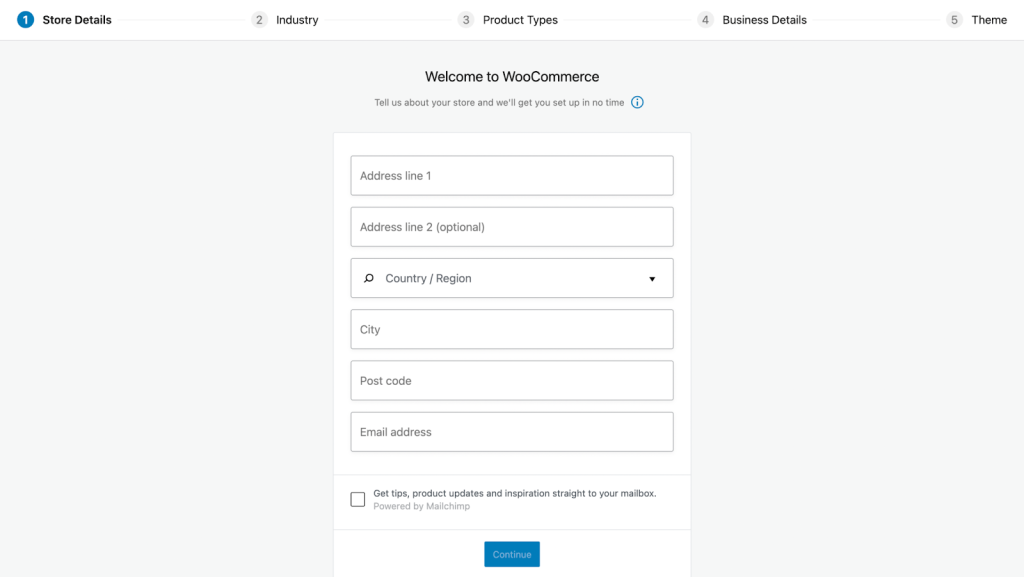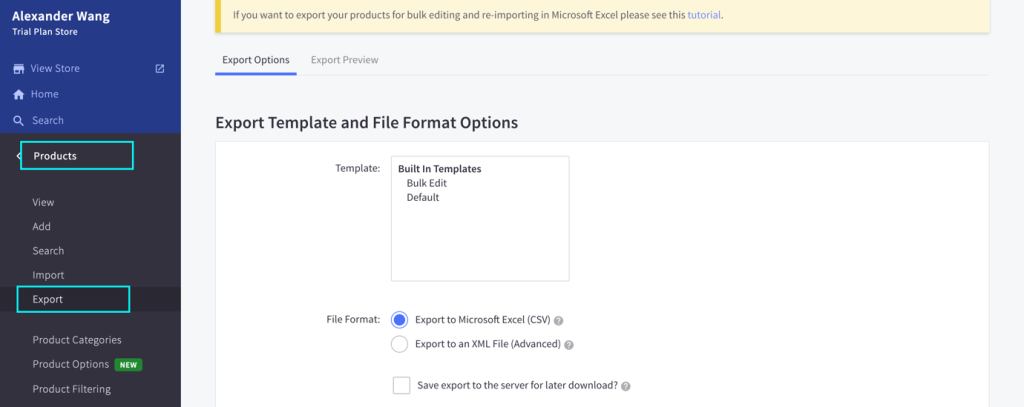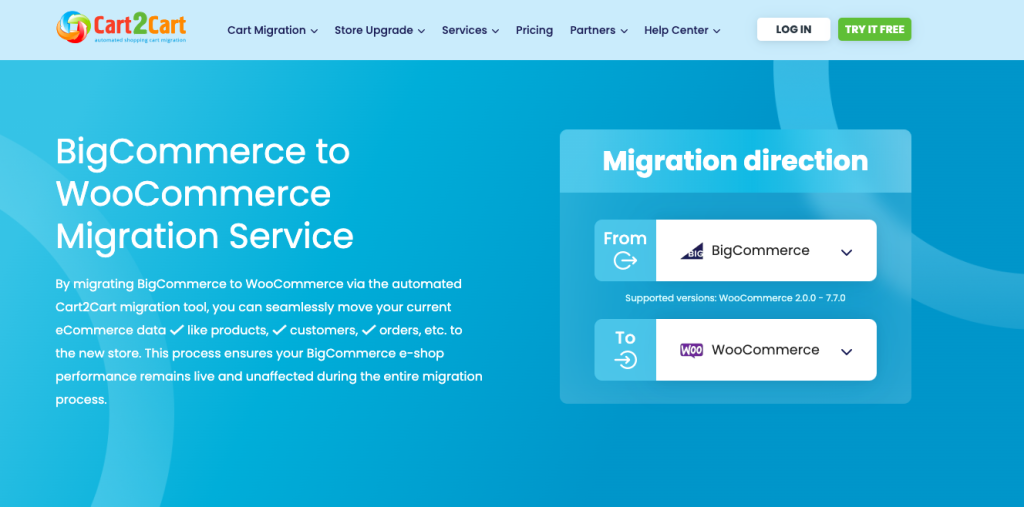Table of Contents
Starting an e-commerce business demands careful platform selection, as it lays the groundwork for automating and optimizing your business procedures. In addition to your distinctive offerings, the right platform should provide a balance of automation and flexibility.
In this comparison, we’ll look at the differences between WooCommerce and BigCommerce in terms of cost, support, convenience, and other factors. You could guarantee sustainable growth for your e-commerce firm by gaining insights into these essential areas. Let’s begin.
WooCommerce Market Share: Powering the Digital Market
WooCommerce, a well-known e-commerce extension designed for WordPress and under the ownership of Automattic – the same team responsible for the WordPress CMS – has garnered substantial acclaim in the online world.
In the expansive digital landscape, WooCommerce has achieved notable renown. It has seized an impressive 38.7% market share within the domain of e-commerce websites. This achievement translates to the empowerment of over 6 million virtual retail outlets.
When casting an eye on the upper echelon of e-commerce websites, specifically the top 1 million, WooCommerce’s influence amplifies further, claiming a considerable 23% stake. This robust statistic firmly establishes it as the preferred preference amid high-traffic e-commerce platforms.
What further reinforces its standing is the extensive constellation of offerings within the WordPress universe: an array of themes, plugins, services, and external tools, all converging to enrich the versatility and capacity for customization that WooCommerce affords.

BigCommerce: Empowering Thousands to Thrive
BigCommerce, on the opposing hand, stands out as a prominent player in the world of e-commerce website construction. It plays a major role in facilitating the realization of online stores for nearly 100,000 people.
As an esteemed e-commerce website builder, BigCommerce assumes the role of a software application that empowers users to establish their personalized virtual shops. What’s interesting is that the scope of its capabilities extends beyond simple creation, encompassing comprehensive guidance in the fields of site management, sales augmentation, and overall digital success.
For those in the earlier stages of business development, seeking to establish an online retail presence, BigCommerce emerges as a wise selection. Its arsenal of in-built functionalities is extensive, optimized by a comprehensive array of tools designed to facilitate expansion. In fact, BigCommerce can assert its ability to nurture a 28% year-on-year growth for the merchants who choose to adopt it. But, is BigCommerce really a good choice for new store owners? Let’s compare WooCommerce and BigCommerce.
Comparing BigCommerce & WooCommerce Platforms
Understanding the core characteristics of an e-commerce platform is essential for effectively evaluating its compatibility with your goals. To support you in making the right choice, we’ve put together a comparative piece between WooCommerce and BigCommerce. This comparison aims to ultimately help you in determining the best solution for your needs.
Features and Tools for E-Commerce Success
Let’s come straight to perhaps the most vital aspect – e-commerce tools and features.
BigCommerce emerges with an impressive arsenal, especially with its sales tools. Its built-in functionalities are designed to be fundamental resources, readily accessible for consistent utilization. From SSL security, visibly protecting payments with padlock symbols during checkout, to multi-channel integration facilitating direct sales on platforms like Amazon and social media giants, BigCommerce offers a comprehensive suite. It empowers businesses to expand their reach across diverse audiences.
Another standout feature is abandoned cart recovery, automating email reminders to entice customers who left items in their cart to complete their purchases. Analytical tracking and reporting tools offer insights into site performance, sales patterns, and the efficacy of email campaigns. This helps with informed decision-making. Additionally, the capacity to generate promotional codes and discounts enhances marketing strategies, translating into improved sales conversion potential.
WooCommerce, on the other hand, employs a different strategy. While it doesn’t boast the extensive native feature set of BigCommerce, instead its open-source platform lets developers and creators from around the world to contribute. As a result, you get almost any type of feature readily available as a plugin (both premium and free versions). All you have to do is to install the plugin and add the feature to your WooCommerce store.

Wondering how to bring back your Abandoned cart users?
Abandoned Cart Pro for WooCommerce is loaded with useful features that help you send an effective volume of reminders via text, email, and messenger. You can also share and manage discount codes that will encourage your customers to complete their orders.
Even better, you can stop the cart abandonment with the exit intent popup!
For instance, you can add the Abandoned Cart recovery feature to a WooCommerce store with the Abandoned Cart Pro plugin. It allows store owners to send abandoned cart reminder emails, SMS, and notifications on the Messenger app to improve the chances of conversion rate.
In a Nutshell
- BigCommerce showcases a robust suite of native features, but WooCommerce emerges with a distinct advantage.
- WooCommerce has a focus on customization and adaptability that gives it an edge. Its emphasis on tailored solutions with plugins and themes is its strength and its flexibility makes it an ideal choice for businesses with unique needs (since it allows users to craft an e-commerce environment aligned precisely with their requirements).
Usability
In terms of usability, both platforms offer distinct approaches that cater to varying needs and levels of expertise.
- Usability
BigCommerce, as a dedicated website builder for online stores, presents a nuanced perspective on usability. The platform offers comprehensive instructions for setting up. However, BigCommerce’s usability is not without its challenges.
A significant hurdle arises in the form of platform-specific terminology. Some users, (particularly those who are new to the world of online commerce) find the jargon used within the platform to be confusing and unfamiliar. This potential barrier could create a somewhat intimidating experience for beginners trying to navigate the platform.
BigCommerce offers a robust foundation for success, featuring a rich set of features – ready for monetization without coding skills. Nevertheless, users must overcome a learning curve associated with the platform’s unique terminology.
Conversely, WooCommerce adopts a different approach to usability. Operating as a plugin for WordPress, WooCommerce surprisingly offers a straightforward setup process via its setup wizard.

In a Nutshell
- Both platforms offer excellent support for the onboarding process. The choice in terms of usability hinges on the user’s familiarity with and comfort level with managing technical aspects.
- BigCommerce offers a comprehensive solution with an array of features.
- WooCommerce’s emphasis on beginner-friendly onboarding may particularly resonate with those seeking an accessible entry point into the world of online selling.
Customization and Design
With regard to the extent of customization available for an online store, BigCommerce and WooCommerce bring meaningful approaches to the table. Both platforms certainly cater to diverse levels of technical proficiency and brand identity needs. They offer an array of themes to elevate a store’s aesthetics, but they differ in cost and adaptability.
- Themes
BigCommerce themes include a selection of 12 free themes and an additional assortment of 50 themes available for a one-time fee ranging from $150 to $300. While this might seem pricey, these themes serve as visual ambassadors for a business’s brand, establishing a strong initial connection with customers.
On WooCommerce’s official platform, there are diverse themes, with many designed specifically for storefronts. Apart from the official theme repository, you can also find some best free WooCommerce themes or purchase premium WooCommerce themes from third-party theme creators.
However, customizing WooCommerce themes requires a minimum level of technical understanding. While it doesn’t mean that the users need to be coding experts, familiarity with WordPress and WooCommerce empowers more comprehensive theme modifications.
- Ease of Customization
Further, the possible level of customization and technicality also distinguishes the two. WooCommerce’s themes are more cost-effective and customizable, demanding a moderate degree of technical skill.
BigCommerce’s themes provide easier editing through an interface that simplifies adjustments to elements like text size, fonts, layouts, and banners. It’s helpful to note that both platforms prioritize mobile responsiveness in their themes. BigCommerce allows direct mobile and tablet screen previews during editing. In WooCommerce, popular website builders like Elementor also let you create responsive designs and preview them in real-time.
In a Nutshell
- While BigCommerce streamlines theme editing, WooCommerce’s themes are cost-effective and more flexible.
- Users’ choice depends on their comfort level with technical intricacies and their vision for a distinctive storefront.
Plugins and Integrations
The integration of plugins holds immense significance in the e-commerce landscape, shaping store capabilities and customer experiences. BigCommerce and WooCommerce take divergent paths in this aspect, offering distinct avenues to meet varying business requirements.
WooCommerce emerges as the standout performer, right off the bat. As mentioned above, the open-source nature of WooCommerce made it the dominant player in the aspect of feature expansion and unique function building. The plugin library is vast, with options available on the official WordPress repository as well as the WooCommerce Marketplace.
WooCommerce adopts a modular approach, offering a foundational set of features while empowering users to mold their store functionalities by adding purpose-specific plugins. The WooCommerce Extensions Store serves as a repository of extensions encompassing marketing, shipping, payments, analytics, and more.
Paid and free extensions coexist within the store, with costs ranging from $30 to $250 per year for paid versions.
Free and premium WooCommerce plugins are there to cater to user’s needs. Integrations with major players like payment providers, shipping solutions, marketing platforms, and Amazon exemplify WooCommerce’s flexibility.
On the other hand, BigCommerce’s strategy leans towards a substantial incorporation of features within the platform. Hundreds of third-party apps and integrations are available in the BigCommerce marketplace, enhancing store capabilities in areas like tax automation, shipping, and marketing.
Ultimately, WooCommerce holds the edge. Its open-source nature and expansive marketplace offer unparalleled adaptability and versatility. While BigCommerce provides commendable integrations, WooCommerce’s capacity to cater to diverse needs, right from the outset, sets it apart.
In a Nutshell
- WooCommerce emerges as the superior option with its customization prowess, extensive marketplace, and potential for tailor-made solutions.
Marketing Capabilities
Marketing capabilities in the e-commerce landscape are critical for reaching the right audience, retaining customers, and driving new business. BigCommerce and WooCommerce present distinct strategies tailored to different business needs and marketing objectives.
BigCommerce recognizes the significance of marketing for businesses of all sizes and includes key marketing features across its plans. These features encompass tools such as blogging, coupons, discounts, gift cards, etc. They also include social media integrations with platforms like Facebook and Instagram, marketplace integrations including eBay and Amazon, and product ratings and reviews.
Moreover, BigCommerce offers Google customer reviews on most plans. For those in need of more, its app marketplace offers a wide range of marketing integrations.
On the other hand, WooCommerce has a handful of marketing features but you can always add relevant plugins to add the features you require. There is a vast assortment of plugins available to users, spanning various aspects of marketing. These include Smart Coupons, Omnisend, Mailchimp, ELEX WooCommerce Google Product Feed Plugin, and more.
Ultimately, WooCommerce emerges as the stronger option in marketing capabilities. Despite offering fewer native tools, its emphasis on customization empowers businesses to craft marketing strategies perfectly suited to their goals. This adaptability proves advantageous for businesses with distinctive marketing approaches or those seeking innovation.
In a Nutshell
- BigCommerce provides a comprehensive suite of built-in marketing tools, but WooCommerce’s customization-driven approach gives it the edge.
Fees, Pricing Plans, and Payment Options
WooCommerce is a free plugin, while BigCommerce operates on a subscription-based model. WooCommerce provides the flexibility to choose hosting providers and service packages that fit within a business’s budget. Although additional costs may be incurred for domain names, premium themes, SSL certificates, and web hosting, businesses have more control over their expenses.
In contrast, BigCommerce offers fixed pricing plans, starting from $29.95 per month for the Standard plan and going up to Enterprise plans with custom pricing. You’ll have to get in touch with customer support to get a quote for your requirements.

In terms of payment options, BigCommerce offers over 65 pre-integrated online payment solutions. WooCommerce does not lag in this aspect, either – with an equally if not more extensive range of payment solutions available.
Additionally, it is pertinent to note that BigCommerce offers support for PayPal powered by Braintree. This starts at a processing fee of 2.59% + $0.49 per transaction across all BigCommerce plans. In contrast, WooCommerce provides a diverse array of payment options without incurring these specific fees.
In a Nutshell
- WooCommerce offers a more cost-effective approach with flexible overall costs, as compared to BigCommerce’s subscription-based model.
- BigCommerce and WooCommerce, both offer various payment mediums; however, BigCommerce charges processing fees while WooCommerce does not.
Support
WooCommerce benefits from a thriving community of developers, experts, and users who actively contribute to its growth and provide support. Extensive documentation, forums, and online resources are readily available to help users find solutions and troubleshoot issues effectively. WooCommerce offers official support channels and premium support options for businesses seeking personalized assistance.
On the other hand, BigCommerce provides support options directly from its dashboard, including phone support, email support, live chat support, and community support. While it ensures that businesses can access assistance 24/7, it lacks the solid community and combined expertise of the WooCommerce support system.
In a Nutshell
- WooCommerce offers support in the form of community-based support, developer support, and forums, as well as access to the source code.
- BigCommerce offers direct support options via several channels but lacks robust community-based support.
Why is WooCommerce Better than BigCommerce?
Ultimately, while both platforms are robust and strong e-commerce platforms, WooCommerce holds a distinct edge over BigCommerce for several compelling reasons.
Its open-source nature grants unmatched customization, enabling businesses to tailor their online stores to exact specifications. The cost-effectiveness of WooCommerce, devoid of ongoing subscription fees, stands out in comparison to BigCommerce’s monthly payment model.
Moreover, WooCommerce’s extensive plugin ecosystem allows users to seamlessly extend their store’s capabilities. It fosters scalability and innovation, while BigCommerce’s reliance on built-in features might limit adaptability.
The familiarity of WooCommerce with WordPress, its strong community support, ownership and control over data, robust SEO and content management tools, and seamless scalability collectively position it as the superior choice. This is especially for businesses seeking a highly customizable, budget-friendly, and versatile e-commerce solution.
Related Article: Wix vs Shopify vs WooCommerce vs BigCommerce vs Magento vs OpenCart
How to Migrate from BigCommerce to WooCommerce
Now that we have compared the key aspects of WooCommerce and BigCommerce, let’s explore the process of migrating from BigCommerce to WooCommerce. If you have decided that WooCommerce is the better fit for your business and want to make the switch, we will briefly guide you through the steps to ensure a smooth transition.
Transitioning from BigCommerce to WooCommerce entails a multifaceted procedure, and while we’ll outline only a handful of fundamental steps, they are crucial in migrating your data and configuring your new store. These initial actions will provide you with a starting point and illuminate the potential for utilizing tools such as Cart2Cart to facilitate the process.
Plan and Prepare
Analyze your BigCommerce store and identify the data and features you want to migrate. Make a checklist of necessary tasks, including product data, customer information, and design elements.

Step 1: Data Backup
Before initiating the migration process, it is imperative to safeguard your existing data. Even if you are entrusting automated tools or professional agencies for the migration, it is wise to have a backup in place to prevent any unforeseen complications. This measure acts as an insurance against any potential risks that might arise during the migration. It’s always better to be proactive in securing your valuable data.
Product and Product Images Backup
- Access your BigCommerce Dashboard.
- Navigate to the “Products” section and select “Export.”
- Opt to back up your products.
- You’ll be directed to the Export Screen.
- Choose “Bulk Edit” to proceed.
- A popup will appear on your screen.
- Select the option “Export my Products to a CSV file.”
- Your product data will be exported to a CSV file.
- Click on “Download my Product File” to obtain the CSV file containing your products and their associated images.
Customer Data Backup
- Under the “Customers” tab, click on “Export.”
- Perform the same process as outlined for product backup to safeguard customer data.
Order Data Backup
- Head to the “Orders” section and choose “Export.”
- Follow the steps identical to those for product and customer data backup.
Step 2: Data Import to WooCommerce
Import
- In your WooCommerce admin area:
- Navigate to “Products” and select “Import.”
- Upload the CSV file containing your exported product data.
- Map the CSV columns to the relevant WooCommerce product attributes.
- Execute the import process.
Follow the same process for other facets such as customer data and order data.
Step 3: Test and Verify Data Integrity
- Test your WooCommerce store meticulously to validate the accuracy of the migrated data, encompassing products, customer records, order histories, and other vital information.
- Scrutinize various aspects such as product pages, checkout processes, customer registration, and payment gateways.
Step 4: Configuration and Optimization
- Payment Gateways: Configure the payment gateways in WooCommerce to match your BigCommerce setup.
- Shipping Methods: Set up shipping methods in WooCommerce to mirror those you had on BigCommerce.
- Tax Settings: Configure the tax settings in WooCommerce based on your business’s jurisdiction and requirements.
- SSL Certificate: Ensure your WooCommerce store is secured with an SSL certificate to safeguard customer data during transactions.
Step 5: Launch and Monitor
- Site Launch: Once you’re satisfied with testing, launch your new WooCommerce store.
- Monitoring: Vigilantly monitor the performance of your WooCommerce store, addressing any issues promptly.
Step 6: Inform Customers and Transition Marketing
- Announce the Migration: Notify your customers about the transition from BigCommerce to WooCommerce.
- Update Marketing Channels: Modify marketing materials, campaigns, and advertisements to reflect your new WooCommerce store’s URLs and branding.
Step 7: Post-Migration Maintenance
- SEO Optimization: Perform an SEO audit to ensure that your new WooCommerce store’s meta tags, URLs, and content are optimized for search engines.
- Regular Backups: Set up periodic backups for your WooCommerce store to prevent data loss.
- Ongoing Maintenance: Continuously monitor and enhance your WooCommerce store by addressing bugs, updating plugins and themes, and enhancing user experience.
Executing a migration from BigCommerce to WooCommerce necessitates meticulous planning and execution. If you’re unfamiliar with technical aspects, it’s recommended to enlist the assistance of experienced developers or agencies. Remember that while this guide provides a comprehensive overview, actual steps may vary depending on your store’s unique setup and requirements.
Cart2Cart Alternative: Simplifying Shopping Cart Migration
Simplify the process of migrating your store to WooCommerce with the seamless assistance of Cart2Cart. In just three straightforward steps, you can effortlessly transfer your BigCommerce store to WooCommerce, with the added convenience of test-driving the process using a complimentary Demo Migration. Importantly, your BigCommerce store can continue operating in the background, ensuring uninterrupted revenue flow throughout the migration procedure.
Cart2Cart facilitates the migration of a diverse range of data, encompassing essential elements such as product details, categories, customer profiles, order history, discount coupons, blog posts, and more.
Moreover, to safeguard your search engine rankings, Cart2Cart offers an option to establish 301 redirects for all your URLs, available for an extra fee. The pricing structure for Cart2Cart is tailored to your store’s dimensions and the extent of data being migrated. Starting at a reasonable price point of $69.00, this package encompasses up to 1000 products, 500 customers, and 500 orders.
Here’s a succinct overview of how you can seamlessly migrate from BigCommerce to WooCommerce using Cart2Cart:
- Connect Your Source Cart (BigCommerce): Provide your current URL and API details to establish a connection.
- Connect Your Target Cart (WooCommerce): Install the required Connection Bridge on your WordPress site either manually or via an automated process.
- Choose and Map Data: Select the specific data types you wish to migrate, and effortlessly map them to corresponding WooCommerce fields.
- Initiate the Migration: Launch the migration process and patiently await its completion, which may vary in duration based on the size of your website.
Your migration is successfully executed, allowing you to start utilizing WooCommerce for your online store.
You can include plugins like Abandoned Cart Pro, Order Delivery Date, and Booking & Appointment

BigCommerce or WooCommerce: Choose What’s Best for Your Business
In the battle between BigCommerce and WooCommerce, it becomes clear that both platforms are excellent options with their unique strengths. It is important that you keep it in mind to analyze your business goals before choosing or switching from one platform to another.
For online store owners, who want to make a unique-looking store that is flexible enough to incorporate features that the future may demand, WooCommerce is the best option. BigCommerce is for store owners who want a set-and-forget experience. Most common features are bundled natively to reduce the hassle, but it takes a learning curve.
No matter which one you choose, you will be having a better experience. The key to choosing the best platform is based on your business’s nature and future scalability.
Read Related: Magento vs. WooCommerce: Which is Better?



